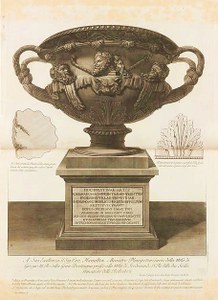Villa Hadriana as a Microcosm A Space of Artistic Interaction in 18th- and 19th-Century Europe
IT>>
DE>>
The research project addresses the multi-faceted reception of the Villa Hadriana near Tivoli in its significance as a “dynamic contact zone” or “space of artistic interaction” in (early) modern Europe. The architectural finds, the building surveys, as well as the varied representations of the grounds and the objects uncovered over the course of centuries illuminate the evolution of archaeology, from the beginnings of the excavation campaigns as mere unearthing and recovery of artifacts up through the modern discipline with its scientific documentation.The complex realized by Emperor Hadrian between 117 and 138 C.E. was  “rediscovered” in the Renaissance and since then could be considered a surface for projecting an idealized ancient culture.
“rediscovered” in the Renaissance and since then could be considered a surface for projecting an idealized ancient culture.  It functioned on the one hand by creating a common experiential space as a basis for European understanding, but served on the other hand – beyond broadening the respective horizons – to develop individual and national concepts. The reception, presentation, and transformation of meaning of the portable decorative elements from the villa complex will be examined on selected examples for their “recontextualization” in private collections and museums. The various areas of inquiry primarily focus on the receiver groups of artists, architects, and draughtsmen, but also the excavators, restorers, and art dealers. With their (literary and visual) records, the representations and concepts, finds and impressions, aspects and notions of the Villa Hadriana were transmitted, which raises numerous questions.Read more [here]
It functioned on the one hand by creating a common experiential space as a basis for European understanding, but served on the other hand – beyond broadening the respective horizons – to develop individual and national concepts. The reception, presentation, and transformation of meaning of the portable decorative elements from the villa complex will be examined on selected examples for their “recontextualization” in private collections and museums. The various areas of inquiry primarily focus on the receiver groups of artists, architects, and draughtsmen, but also the excavators, restorers, and art dealers. With their (literary and visual) records, the representations and concepts, finds and impressions, aspects and notions of the Villa Hadriana were transmitted, which raises numerous questions.Read more [here]
Related events
- Exhibition 2019 // Phoenix aus der Asche. Bildwerdung der Antike - Druckgrafiken bis 1869 / L’Araba Fenice: La visualizzazione dell’Antico nella grafica a stampa fino al 1869, curated together with Ulrich Pfisterer (June 27–September 22, 2019, Zentralinstitut für Kunstgeschichte, Munich)
-
Lecture Series 2018-2020 // Villa Hadriana: die kaiserliche Residenz und ihre Rezeption / Program
Upcoming Lecture: Villa Adriana: Die kaiserliche Residenz und ihre Rezeption / Teil 5 (10. Juli 2020)
[see more]
Duration
April 2017 - November 2020
Publications
- I Piranesi e il loro contributo all’indagine e allo spoglio, in: Giuseppina E. Cinque and Nicoletta Marconi (eds.), Villa Adriana. Passeggiate iconografiche, Foligno: Il Formichiere, 2018, S. 81–95.
- (with U. Pfisterer), Phönix aus der Asche, oder: Auferstehung, Nachleben und Untergang der Antike in (druckgrafischen) Bildern, in: Phönix aus der Asche. Bildwerdung der Antike – Druckgrafiken bis 1869/L’Araba Fenice. L’Antico visualizzato nella grafica a stampa fino al 1869 (exhibition catalogue, Munich 27.6.-22.9.2019), ed. by Ulrich Pfisterer and Cristina Ruggero (Veröffentlichungen des Zentralinstituts für Kunstgeschichte in München; Band 50), Petersberg: Imhof Verlag 2019, p. 6–19.
- La fortuna visiva di Villa Adriana fra documentazione scientifica e diffusione culturale (1870-1930), in: Phönix aus der Asche. Bildwerdung der Antike – Druckgrafiken bis 1869/L’Araba Fenice. L’Antico visualizzato nella grafica a stampa fino al 1869 (exhibitions catalogue, Munich 27.6.-22.9.2019), ed. by Ulrich Pfisterer and Cristina Ruggero (Veröffentlichungen des Zentralinstituts für Kunstgeschichte in München; 50), Petersberg: Imhof Verlag 2019, p. 372–389.
- Hadrian’s Villa: a source of inspiration for Neoclassical Russia?, in: Actual Problems of Theory and History of Art: Collection of articles, Vol. 10, ed. by A.V. Zakharova, S.V. Maltseva and E. Yu. Staniukovich-Denisova, St. Petersburg (forthcoming).
- Villa Adriana: “taste and manners of the different nations”, in: Adventus Hadriani (convegno internazionale di studi di architettura, Tivoli 03.-06.07.2018), ed. by Giuseppina E. Cinque, Rafael Hidalgo Prieto, Antonio Pizzo, Alessandro Viscogliosi, Rome: L’Herma di Breitschneider (collana Hispania Antigua) (forthcoming.
- Udjaḥorresnet’s naoforo vaticano: acquisition and exhibition, in: Udjahorresnet and his world, ed. by Melanie Wasmuth und Pearce Paul Creasman, in: Journal of Ancient Egyptian Interconnections [special issue] (forthcoming) .
- Villa Hadriana in Tivoli. Wahrnehmungsprozesse und Darstellungsmodi eines künstlerischen Interaktionsraums in der Frühen Neuzeit, (Akten der Tagung Drawing. Imagination and Perception – Zeichnung. Imagination und Wahrnehmung, Munich 30.06.-01.07.2017), ed. by Claudia Steinhardt-Hirsch, Passau: Klinger Verlag, (being prepared) .
- “Dagli scavi di Tivoli sono nuovamente uscite le seguenti sculture”. Ausgrabungsfunde aus der Hadriansvilla in neuen Ausstellungskontexten, in: Aufbewahren, Transportieren, Inventarisieren – Objekte und ihre Ordnung in der Frühen Neuzeit (Akten des 3. Jahrestreffens des Arbeitskreises „Materielle Kultur und Konsum in der Vormoderne - Stuttgart 8.-10.11.2018) ed. by Mona Garloff and Natalie Krentz, [Sonderheft der Zeitschrift MEMO – open access Journal] (being prepared) .
